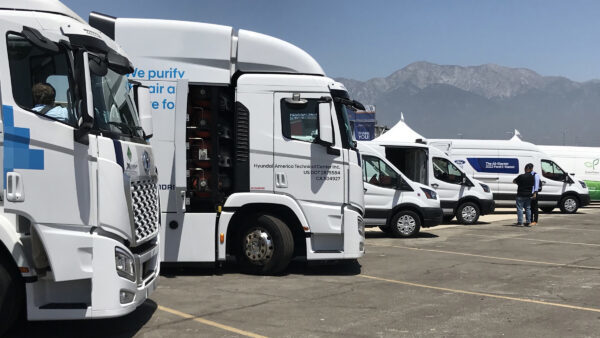White House endorses global push for renewable fuels in trucks and buses
Non-binding agreement backs California’s plan that 100% of new medium- and heavy-duty vehicle sales would be zero-emission by 2040.

The Biden Administration has endorsed an international plan that would slash climate emissions from trucks and buses by requiring the sale of renewable-fuel vehicles, according to an announcement from the COP27 diplomatic retreat in Sharm el-Sheikh, Egypt.
Specifically, the non-binding agreement supports a path to 100% new zero-emission medium- and heavy-duty vehicle (MHDV) sales by 2040 with a targeted floor of 30% new zero-emission MHDV sales by 2030. The plan for reaching zero-emission transport is co-led by California’s CALSTART Drive to Zero program and the Netherlands, and is formally known as the “Global Memorandum of Understanding (Global MOU) on Zero-Emission Medium-and Heavy-Duty Vehicles.”
Alongside the U.S., the deal has also been endorsed by 16 nations as well as a collection of local governments, manufacturers, and suppliers. That latter group includes the U.S. state of California, Québec (Canada), Telangana (India), Berlin’s Partner for Business and Technology, Scania, Dannar, Lion, Heineken, and DHL.
A group of U.S. Congressmen led by Sen. Martin Heinrich (D-NM) praised the move, saying in a letter to President Biden that transitioning to zero-emission transportation will improve air quality and enhance national security by “reducing our reliance on foreign oil and shielding consumers from disruptive volatility in fuel costs.”
Support also came from logistics industry member DHL, the German parcel delivery and logistics service provider. “As a global leader in logistics and delivery services, DHL Express has long recognized the important role that our industry plays in decarbonizing the transportation sector. The Global MOU and the growing list of signatory countries and endorsing organizations signing on at COP27 is a significant and welcome development. We look forward to working with these governments and peers as we deploy zero-emission vehicles and the necessary infrastructure to make them a reality,” Greg Hewitt, CEO of DHL Express, US, said in a release.
The news closely follows a proposed rule unveiled on Nov. 10 by the White House to require major federal contractors—those receiving more than $50 million in annual contracts—to publicly disclose their greenhouse gas emissions and climate-related financial risks and to set science-based emissions reduction targets.
While those largest contractors would be required to disclose Scope 1, Scope 2, and relevant categories of Scope 3 emissions, smaller contractors with at least $7.5 million in annual contracts would need to share data on just Scope 1 and Scope 2 emissions, and companies providing services worth less than $7.5 million would be exempt entirely.
According to the U.S. Environmental Protection Agency (EPA), Scope 1 emissions are defined as those directly caused by a company, such as its own facilities and vehicles. Scope 2 emissions come from indirect purchases including electricity used for heating and cooling, and Scope 3 emissions are traced to even less direct products, like financial investments, business travel, and outsourced transportation and distribution.
If the proposed rule is implemented, such steps could make a firm impact on emissions, since they could lend greater clarity in the new and developing field. Many businesses currently struggle to make climate-focused change because they lack industry standards, common regulations, and precise data, according to Simon Geale, executive vice president of procurement at Proxima, a procurement and supply chain consultancy.
“There will be some adoption challenges, but nobody said that decarbonization was going to be easy,” Geale said in an email. “As it stands, this looks like the first in a series of tightening regulations, focusing first on larger firms, who in all likelihood are already somewhat familiar with the challenge at hand, but as those businesses get further down the line with Science Based Targets and emissions reduction, harder, more complex things need to be done which will require partnerships, technology and new approaches from their teams. On the other side of the fence, those [booking] contracts will also need to up the literacy in this space to be able to encourage and assess plans from their current and potential suppliers.”
As one of the biggest truck markets and economies in the world, the #USA has the power to transform transport for good - and that is what it is doing. #COP27 the US signed the Global MOU, supporting a path to 100% #ZeroEmission new trucks by 2040.https://t.co/T6lwMCpRLA pic.twitter.com/LpnmdIKAMA
— Global Commercial Vehicle Drive to Zero (@TeamDriveToZero) November 17, 2022
Related Articles

Copyright ©2024. All Rights ReservedDesign, CMS, Hosting & Web Development :: ePublishing